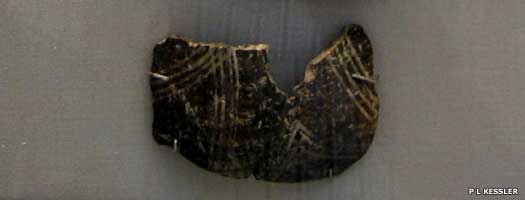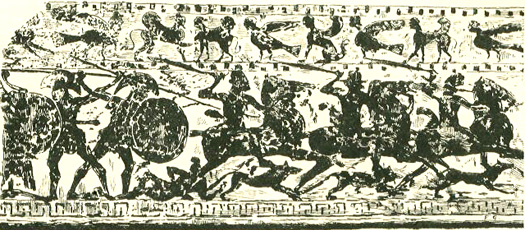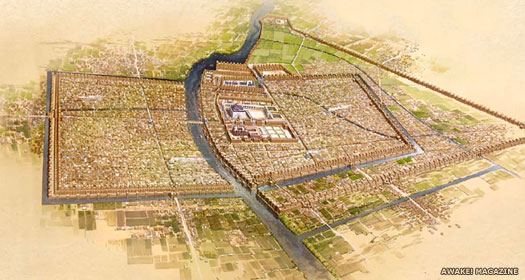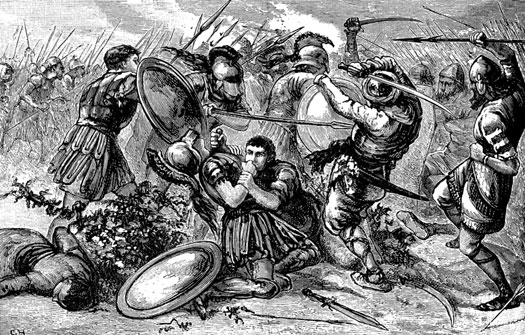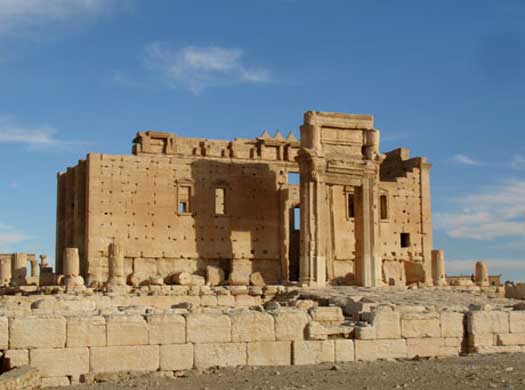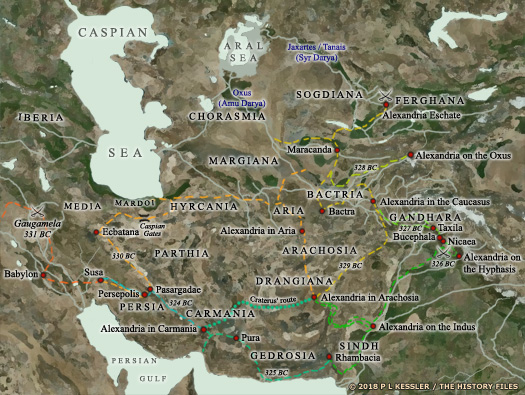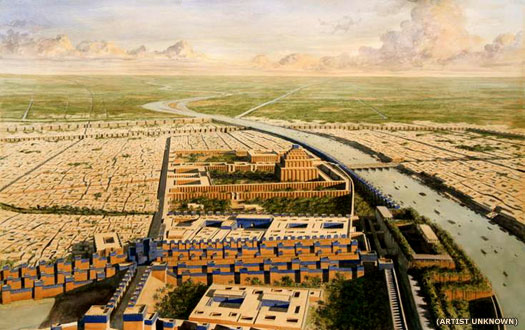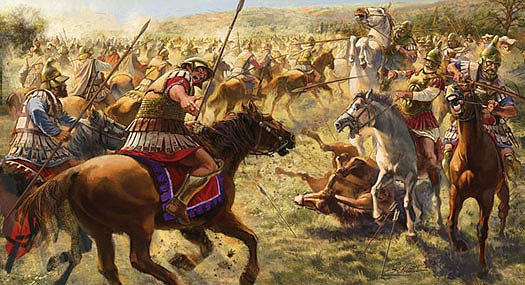
| MESOPOTAMIAN STATES Mesopotamia saw the appearance of one of the earliest-known modern human cultures outside of Africa, in the form of the Baradostian. In the thirty thousand years since then the region had usually been at the forefront of human cultural progression, By the fourth millennium BC, the first city states had appeared in Sumer and Akkad in southern Mesopotamia, and by the third they were flourishing with creative ideas and large populations. The relatively few northern Mesopotamian (and Syrian) states which appeared in the third millennium BC differed somewhat from their southern contemporaries. Instead of relying on river irrigation, the agriculture of the north was rain-fed, so yields were lower and larger areas had to be cultivated (though with less labour). As a result, northern cities tended to be smaller with more people living in outlying settlements. Although they were still city states at heart, they had more of an appearance of being small kingdoms.
Amorites began to filter into Syria and Mesopotamia from around 2500 BC. The Akkadians called them Amurru, and groups of them arrived in Sumer where they eventually replaced the Sumerians as rulers in Mesopotamia. In the north they founded many new city states in areas which were much less developed or advanced than in the south. By 2100 BC non-Semitic Hurrians were filtering into these newly developed areas from the north, and between the indigenous population, the groups of Akkadians who had been there for some time, and the new arrivals, the population and culture in the north was extremely varied. Although most of the Syrian and northern Mesopotamian peoples spoke Semitic dialects by the first part of the second millennium BC, Hurrian names could be found as far south as Nippur, indicating a level of linguistic heterogeneity throughout much of Mesopotamia. Scribal practices were adopted from the south and were apparently taught by Babylonians.
(Additional information from The Horse, the Wheel, and Language: How Bronze-Age Riders from the Eurasian Steppes Shaped the Modern World, David W Anthony.)
3700 - 3300 BC :
In far south-eastern Europe, in the North Caucasus Mountains, spectacularly ostentatious chiefs suddenly appear amongst what had previously been very ordinary small-scale farmers. They display gold-covered clothing, gold and silver staffs, and great quantities of bronze weapons obtained from the newly formed cities of Middle Uruk Mesopotamia, through Anatolian middlemen. This is probably the first true contact between southern urban civilisations and the people of the steppe margins, taking place about 3700-3500 BC, and it forms the basis of the creation of Maikop culture.
Something less obvious to many is that cannabis may be travelling in the opposite direction to the gold and silver that is coming from the south - this time travelling from the Pontic-Caspian steppes to Mesopotamia and the early city states of Sumer. Greek kdnnabis and proto-Germanic *baniptx seem to be related to the Sumerian kuriibu. Sumerian dies out as a widely spoken language after around 2000 BC, so the connection must be a very ancient one. The international trade of the Late Uruk period (circa 3300-3100 BC) provides a suitable context for this trade.
c.3300 BC :
The earliest civilisation flourishes in Sumer in southern Mesopotamia during the Uruk IV period. Making the most of new irrigation systems, the population expands rapidly and creates approximately a dozen city states.
This fragment of Early Bronze Age pottery was produced in Mesopotamia around 3000 BC, as the early city-building movement there began to accelerate towards large-scale city states and a recorded history c.2600 - c.2200 BC :
By this date, Sumerian civilisation in the south is at its height. Although their creation is later than those of Sumer, the early Akkaddian or Amorite city states of the north are less well attested, and many of them are only known from later writings.
Those which can be identified by name include Apum, Ashnakkum (modern Tell Chagar Bazar), Nawar, and Urkesh in the Khabur region of what is now north-eastern Syria, Harran, Mari and Terqa along the Euphrates, Kunara of the Lullubi in modern Kurdistan, and Arbel, Ashur, and Ninevah in the east (the early Assyrians). These states are in contact with each other through diplomatic and commercial means.
Some of these centres in northern, or upper, Mesopotamia - Mari, and Nawar - seem to be able to impose their will on surrounding states, but many of the details of their military actions are unknown.
c.2200 BC :
Northern Mesopotamia is disrupted by invasions by barbarians from farther north - such as the Gutians - and by the cold, dry period in the Near East which lasts for three hundred years.c.2000s BC During the flourishing of Ur's third dynasty in Sumer, Syrian states maintain friendly relations with the south. However, following the fall of Ur there is a reduction in the number and sizes of settlements in the north for reasons unknown. Documentation suffers a gap of almost two centuries before the start of the archives at Mari.
c.1850 - 1776 BC :
Northern Mesopotamia has recovered fully and a wave of newer small states or fully urbanised cities become apparent, including Andarig, Apum, Karana, Qattara, Razama, Shushara (Shemshara), and Terqa, making up a system of kingdoms whose rulers keep large palace archives of diplomatic correspondence showing how vital it is that they remain informed. In about 1809 BC, Northern Mesopotamia and areas of Syria are conquered by the kingdom of Upper Mesopotamia. But after the death of the kingdom's founder in about 1776 BC, it swiftly breaks up and the old order reasserts itself. Local rulers are constantly wary of the larger states, Babylon, Elam or Eshnunna, which can make or break them.
c.1800? BC :
Yahdun-Lim of Mari sends troops to join those of Yamkhad to fight against several hostile Syrian 'states', including Tuttul, defeating their armies and attacking their towns. The other states which are allied to Tuttul and are defeated alongside it are as follows (all three are Yaminite towns located close by Terqa, under Mari's overall control, and headed by little more than tribal organisations):
La'um : Amorite king of the city of Samanum & the land of Ubrabu.
Ayalum : Amorite king of the city of Abattum & the land of Rabbum.
c.1770s BC :
Bahdi-Lim, an official of the court of Zimri-Lim of Mari in the city of Tuttul, records the arrival of Dagan's entry into the city, accompanied by two persons. One of these is a Yaminite chief, and the other, Sumu-laba, may also be a chief.
Dadi-hadun : Amorite chief of the tribe of Rabbeans.
Sumu-laba : Amorite chief (possibly) of the clan of the Uprapeans?
c.1760s BC :
The city state of Babylon suddenly expands under Hammurabi to conquer huge swathes of southern, central, and northern Mesopotamia, including many of the states mentioned above.
c.1730 - 1720 BC :
The Kassites invade Mesopotamia, penetrating deep into the south. There they are defeated by the Sealand Dynasty of Babylon and are expelled from southern Mesopotamia. They retreat north to take over the near-abandoned city of Mari, also expanding into nearby Terqa. By now the intensive palace system of the high number of states in Upper Mesopotamia has become unsustainable. Many cities are abandoned, perhaps due to a combination of popular opposition to the system and changes in rainfall patterns. The historical record for this region disappears.
c.1595 BC :
Mursili's Hittites capture and destroy Alep on their way south to sack Babylon, ending the political situation that had characterised Syria and Mesopotamia for four centuries. Many states, such as Apum, all decline. The region enters a dark age which lasts for up to a century and a half in some areas. The power vacuum allows Hurrians to migrate westwards, and the Kassites to take control of Babylon.
c.1450 BC :
The Hurrian state of Mitanni suddenly expands to encompass many northern Mesopotamian and Syrian cities.
c.1360 BC :
The resurgent Assyrians throw off their overlords, the Hittites, and establish firm control over the heartland of Assyria - the Tigris Valley and the plains to the east, and from Ashur to the Taurus Mountains in the north.
c.1200 BC :
In the face of a general collapse of authority in Syria and a marked decline in northern Mesopotamia, including within Assyria, Aramaean tribes migrate into both regions and begin to attack and take over many cities. Some cities are abandoned in the face of these attacks, such as Qattara.
This is also the period of Israelite settlement after the exodus from Egypt. At this time, there is general instability in the region: the Hittite empire is destroyed in Anatolia, the Canaanites begin to be reduced to owning the shores of what is now Lebanon (eventually to become the sea traders known as the Phoenicians), the Philistines and other Sea Peoples are first settling on the lower coast of the Levant, and various neo-Hittite city states are arising in northern Syria, many of which come into contact with the Israelites.
Mesopotamian Empires :
The first millennium BC was an age of empires in Mesopotamia. There was a succession of them that would continue to rule the region in one form or another for over a thousand years. First came the Assyrians and their successors, the Babylonians. Then the Persians from the east, the Greeks from the west, the Parthians from the east again, and finally the Islamic empire. Only when the last of these began to weaken did a situation of fragmented states arise to match that of the second millennium BC.
(Additional information from Europe Before History, Kristian Kristiansen, from Unger's Bible Dictionary, Merrill F Unger (1957), and from Easton's Bible Dictionary, Matthew George Easton (1897).)
c.900 BC :
From around this date, rich, well-organised 'kingdoms' or 'chiefdoms' develop in the Caucuses. They interact with civilisations to their south, in Anatolia and Mesopotamia, usually by raiding into their territory. Typical horse bits and cheek-pieces of an early Thraco-Cimmerian type are found by archaeologists in the same region of the Caucuses.
This image shows Cimmerians battling early Greeks - prior to the advent of accepted 'Classical' Greece - with the mounted Cimmerians warriors apparently being accompanied by their dogs 884 BC :
As the dark age draws to a close, Assyria rises to become the dominant force in northern Mesopotamia and Syria.
714 - 713 BC :
Much to the shock of Sargon of Assyria, while his main army is occupied in the east, Ambaris of Tabal allies himself with Midas of Phrygia and Rusa of Urartu (possibly immediately before the latter's suicide), as well as the local Tabalean rulers in an attempt to invade Que. Sargon reacts quickly, invading Tabal and capturing Ambaris, his family and the nobles of his country, all of whom are taken to Assyria. Tabal is annexed as an Assyrian province. Sargon is noted for using Cimmerians within his army on this campaign, possibly for their knowledge of the Urartuan hills as much as their ability as mounted warriors. Cimmerians have been raiding into Mesopotamia for decades.
653 BC :
Tugdamme of the Cimmerians begins to threaten the borders of the powerful Assyrian empire during the reign of Ashurbanipal. Assyrian inscriptions record him as being 'King of the Saka and Qutium'. This is very telling, because it suggests that he rules not only over his own Cimmerian people (which is so obvious that it need not be mentioned), but also the Scythians. The 'Qutium' in point would seem to be 'Gutium', homeland in the Zagros Mountains between modern Iran and Iraq of the nomadic Gutians (often thought to be the precursors of the Kurds). Clearly Tugdamme has already conquered territory very close to the heartland of the Assyrian empire, making it more possible that the Scythian masters of the Medes at this time are in fact the Cimmerians.
Assyrian inscriptions also refer to Tugdamme as 'Sar Kissati' which translates as 'King of Kish' or 'King of the World'. Kish is an ancient and highly important city state in southern Mesopotamia, which suggests that Tugdamme now rules a vast area of land to the east and south of the Assyrians.
612 - 605 BC :
Assyria falls and a resurgent Babylonia gains control of much of its former territory, including Syria, despite an attempt by Egypt to prevent this.
Persian
Satraps of Mesopotamia :
Between 550-539 BC, Persia arose on the Iranian plateau as a formidable power. The empire of Babylonia was taken by Cyrus the Great in 539 BC and was added to the Persian empire. Along with that came control of Mesopotamia and Syria, followed by Anatolia, and much more territory in the east. The new masters administered the captured territories as satrapies, governed regions, with the post in (southern) Mesopotamia first going to one of Cyrus' generals. In the fourth century, the invading Greeks maintained the practise, replacing Persians with Greek or local satraps.
Mesopotamia in general was divided at what is known as 'the bottleneck' in the region of modern Baghdad. The southern section was under the authority of Babylon while the north was part of Athura (former Assyria), although the latter was itself initially under Babylon's overall authority. To the east the border was formed by the Tigris opposite Sittacene and Susiana, while to the west the desert of Arabaya functioned as a natural boundary. The Euphrates seperated Mesopotamia from Ebir-nari and Katpatuka.
At the heart of southern Mesopotamia, Babylonia was not unknown to the Greeks whose records are largely relied upon today. Even during the Achaemenid period many Greeks travelled here, some as traders, some as Persian military allies and some, like Herodotus, on journeys of exploration. There seems not to have been a Greek community in Babylon before the Argead conquest, however. Herodotus appears to have had trouble in finding enough information to properly fill out his Babylonian entry (such as an account of the city's past kings). Babylonian business documents bear this out. People they often call Greeks in fact have Anatolian names. Nomenclature also bears this out, as the Greeks do not know the two great rivers of Mesopotamia by their universal regional names, Purat and Deklath, but from the Medo-Persian corruptions of them - Ufratush and Tigra (the modern Euphrates and Tigris).
Where these are known, the Old Persian names of the satraps are shown first, followed by Greek and other various interpretations. The satraps of Persian Babirush (Babylonia) are poorly attested, especially after the post appears to become less important in the fifth century BC. The region of Gutium covered parts of the central Zagros Mountain range. Nothing is known about the origins of the Gutian people who gave it this name but they briefly conquered Sumer in the 2200s to 2100s BC before being ejected by the king of Uruk. By the Persian period the region was still little-known, but also of little apparent trouble.
(Information by Peter Kessler, with additional information from Jewish War & Jewish Antiquities, Flavius Josephus, from The Persian Empire, J M Cook (1983), from The Histories, Herodotus (Penguin, 1996), from the Cyropaedia & Anabasis, Xenophon of Athens, from The Cambridge Ancient History, John Boardman, N G L Hammond, D M Lewis, & M Ostwald (Eds), from Ancient and Modern Assyrians: A Scientific Analysis, George V Yana (Xlibris Corporation, 2008), and from External Links: Encyclopædia Britannica, and Appian's History of Rome: The Syrian Wars at Livius.org, and Diodorus of Sicily at the Library of World History (dead link), and Encyclopaedia Iranica, and the Nabonidus Chronicle, contained within Assyrian and Babylonian Chronicles, A K Grayson (Translation, 1975 & 2000, and now available via Livius in an improved version).)
539 - 537? BC :
? : Babylonian satrap of Mesopotamia, Ebir-nari, & Phoenicia.
539 BC :
Despite the fall of Babylon itself to the Persians, it is entirely possible that pockets of resistance remain - or at least areas in which Persian overlordship is tacitly acknowledged while local rule is maintained on a semi-independent basis, at least for a time. The Chaldeans who had provided Babylon's last dynasty of kings may be one such case. Although specific details are not recorded, the Book of Daniel seems to retain a memory of this in Belshar-uzur.
Babylon was forever diminished by its roles in two major uprisings in the fifth century BC and by its subsequent demotion in importance - even the arrival of the Greeks did not revive its fortunes fl c.539 BC :
Belshar-uzur / Bel-sarra-Uzur : Son of Nabonidus. The Belshazzar of the Book of Daniel.
539 BC :
Belshar-uzur
is the son of Nabonidus and may legitimately claim to be the
true successor to the throne even though he holds no power and
doesn't have the resources to enforce his claim. He is apparently
killed by Cyrus the Great even though his father is allowed
to live, so he cannot be the otherwise unknown satrap of Babirush
for the first couple of years of Persian rule before being replaced
by Gaubaruva. Instead, as Cyrus allows existing offices to be
retained at first, this post is probably still filled by its
Neo-Babylonian incumbent.
539 - 538 BC :
Ugbaru / Gobryas : Satrap of Gutium. General who helped conquer Babylon. Died.
537? BC :
Gaubaruva is appointed as the first Persian satrap of Babirush (Babylonia). He is known by a whole host of interpretations of his name, from the Old Persian Gaubaruva or the Akkadian Gubaru, to the Greek Gobryas, and the Latin Gobar(es). He can also be equated with the Cyaxares of the Cyropaedia, but should not be confused with the General Ugbaru (Old Persian) or Gobryas (Greek) who aids Cyrus the Great in the conquest of Mesopotamia (a mistake made in the Grayson version of the Nabonidus Chronicle). Ugbaru may in fact govern the district or province of Gutium for a short time (land of the Gutians) before dying, having already reached an advanced age.
537? - 522 BC :
Gaubaruva / Gobryas / Gobares : Persian satrap of Mesopotamia, Babirush, Ebir-nari, & Phoenicia.
524? - 516 BC :
Uštani / Ushtanni : Satrap of Babirush (Mesopotamia), Ebir-nari, & Phoenicia.
c.484 BC :
Although any records to prove it have not survived, it would seem to be in this period, between about 490-482 BC, in which Ebir-nari is created a satrapy in its own right, removing it from the administration of Babirush (Babylonia). The cause may well be the revolt which arises shortly after a greater revolt in Egypt. In fact tablets from Babylonia seem to show evidence of two risings by claimants to the Babylonian throne. The first uprising is that of Bel-shimanni, which can perhaps be dated to the high summer of 484 BC. This seems only to last a week or two before being put down.
The Battle of Cunaxa in 401 BC saw the end of just one in a number of internal Persian revolts that often involved thousands of troops on either side, although in this case the presence of a large body of Greek mercenaries should have been an indicator of the future threat the Greeks would become fl 421 - 404? BC :
Gobryas : Satrap of Babirush (Mesopotamia).
c.421 / 420 BC :
This
Gobryas could be the same figure as one of the four commanders-in-chief
of the army of Artaxerxes II at the battle of Cunaxa in 401
BC as noted by Xenophon. As satrap of Babirush, Gobryas is named
in several documents from the Murašû archive in Nippur
which is dated to the years 421/420 BC to 417/416 BC. He probably
remains in that office until the accession of Artaxerxes II
in 404 BC - a prime time for reorganising officials.
fl 401 - ? BC :
Roparas : Satrap of Babirush (Mesopotamia).
401 BC :
Roparas
is assigned the position of satrap of Babirush (according to
Yana and Cook). Nothing more appears to be said about him, but
the seeming coincidence of having two satraps with the same
name within seventy years suggests a degree of familial relationship,
probably a grandson or great nephew.
fl mid-300s BC :
Roparas : Satrap of Babirush (Mesopotamia). Lost post to Greeks?
331 BC :
The region is conquered by the Greek empire under Alexander the Great. At the Battle of Gaugamela, Darius' Persian units in the centre of the formation take heavy casualties, but the commander of one of those divisions, Ariobarzanes, satrap of Persis, is able to leave the battlefield with his king. Darius flees eastwards and the defence of each province is left to its satrap.
The propyleum and cella of the Temple of Bel, which incorporates Mesopotamian, Greek and Roman elements and dates primarily to the first and second centuries AD Mazaeus, the satrap of Ebir-nari, initially plays his part by opposing Alexander, but he eventually surrenders, and Alexander makes him satrap of Argead Mesopotamia, Alexander seizes Babylon (where Xenophon lists Roparas as satrap) and Susa and, having gathered intelligence on Persis, he soon captures that too. Most administrative posts are retained under the Greek empire, including some of those in Mesopotamia.
Argead Dynasty in Mesopotamia :
The Argead were the ruling family and founders of Macedonia who reached their greatest extent under Alexander the Great and his two successors before the kingdom broke up into several Hellenic sections. Following Alexander's conquest of central and eastern Persia in 331-328 BC, the Greek empire ruled the region until Alexander's death in 323 BC and the subsequent regency period which ended in 310 BC. Alexander's successors held no real power, being mere figureheads for the generals who really held control of Alexander's empire. Following that latter period and during the course of several wars, Mesopotamia was largely left in the hands of the Seleucid empire from 305 BC.
At the heart of southern Mesopotamia, Babylonia was not unknown to the Greeks. Even during the Achaemenid period many Greeks travelled here, some as traders, some as Persian military allies and some, like Herodotus, on journeys of exploration. Nomenclature bears out the lack of any permanent Greek presence here though, as the Greeks do not know the two great rivers of Mesopotamia by their universal regional names, Purat and Deklath, but from the Medo-Persian corruptions of them - Ufratush and Tigra (the modern Euphrates and Tigris).
After 305 BC, Seleucid rule brought changes to Mesopotamia, especially in cities in which Greeks and Macedonians were settled. In these cities separate agreements were usually made with the Greek officials regarding civil and military authority, and immunity from taxes or levees and the like. Native cities continued to employ their old systems of local government, much as they had under the Achaemenids. Greek gods were worshiped in temples that were dedicated to them in the Greek cities, and native Mesopotamian gods had temples dedicated to them in the native cities. However, although an enforced policy of Hellenisation was not followed, Greek ideas and practices did filter down and were gradually adopted. There is no evidence from the east to show that Greek religious beliefs were especially prevalent amongst the local population to the detriment of local forms of worship, but there is no record of persecution. On the contrary, the rulers seem to have favoured local religious practices, and ancient forms of worship continued. Cuneiform writing by priests, who copied incantations and old religious texts, continued into the Parthian period.
(Information by Peter Kessler, with additional information from Jewish War & Jewish Antiquities, Flavius Josephus, from The Persian Empire, J M Cook (1983), from The Histories, Herodotus (Penguin, 1996), from the Cyropaedia & Anabasis, Xenophon of Athens, from The Cambridge Ancient History, John Boardman, N G L Hammond, D M Lewis, & M Ostwald (Eds), from Ancient and Modern Assyrians: A Scientific Analysis, George V Yana (Xlibris Corporation, 2008), from Brill's Companion to Alexander the Great, Joseph Roisman (BRILL, 2002), and from External Links: Encyclopædia Britannica, and Appian's History of Rome: The Syrian Wars at Livius.org, and Diodorus of Sicily at the Library of World History (dead link), and Encyclopaedia Iranica, and the Nabonidus Chronicle, contained within Assyrian and Babylonian Chronicles, A K Grayson (Translation, 1975 & 2000, and now available via Livius in an improved version).)
331 - 323 BC :
Alexander III the Great : King of Macedonia. Conquered Persia.
323 - 317 BC :
Philip III Arrhidaeus : Feeble-minded half-brother of Alexander the Great.
317 - 310 BC :
Alexander IV of Macedonia : Infant son of Alexander the Great and Roxana.
331 - 328 BC :
Mazaeus / Mazdai : Persian satrap of Babylonia. Died 328 BC.
328 - 323 BC :
Stamenes : Greek satrap of Babylonia (and Mesopotamia?). Died?
323 - 320 BC :
Arcesilas / Arcesilaus : Greek satrap of northern Mesopotamia. Removed or fled?
322 - 320 BC :
Immediately following Alexander's untimely death in 323 BC, Susiana is presumably governed by Archon of Pella, who holds Babylonia in the name of the titular successors to the empire. Arcesilas is confirmed in northern Mesopotamia (but not Babylonia as is sometimes claimed, thanks to the presence of Archon of Pella).
The First War of the Diadochi (the successors - the generals of Alexander's army) between 322-320 BC sees civil war break out between the generals, and Perdiccas, regent of Macedonia, is murdered by his own generals during an invasion of Egypt. Alexander's successor, Philip III, agrees terms with the murdering generals and appoints them as regents.
Despite its gradual relegation as a place of importance in the face of the Greek preference for Seleucia, Babylon was still of huge importance in Mesopotamia, as can be seen in this unknown artist's impression of the city, while above is the route of Alexander's ongoing campaigns across the ancient world 320 BC :
A
new agreement with Antipater makes him regent of the Macedonian
empire and commander of the European section. The Antigonids
remain in charge of Lycia and Pamphylia, to which is added Lycaonia,
Syria and Phoenicia, making Antigonus commander of the Asian
section. Ptolemy retains Egypt, Lysimachus retains Phrygia and
Thrace, while the three murderers of Perdiccas - Seleucus, Peithon,
and Antigenes - are given the former Persian provinces of Babylonia,
Media, and Susiana respectively.
Arrhidaeus, the former regent, receives Hellespontine Phrygia, while in northern Mesopotamia, Arcesilas seems to have fallen from grace. It is assumed that, as a one-time supporter of Perdiccas, he has opposed Seleucus Nicator who soon decides that he wants the entire region in his soon-to-be-created Seleucid empire. Amphimachus becomes his replacement.
320 - ? BC :
Amphimachus : Greek satrap of northern Mesopotamia.
319 - 315 BC :
The death of Antipater leads to the Second War of the Diadochi. Philip III is killed by his stepmother, Olympias, in 317 BC with her being killed by Cassander the following year. Cassander also captures Alexander IV and Roxana and installs a governor in Athens, subsuming its democratic system. Eumenes is defeated in Asia and murdered by his own troops, and Seleucus is forced to flee Babylon by Antigonus in 315 BC. By this point Amphimachus already seems to be satrap no more, although his fate is not known.
Even in the early days of the Assyrian rise to power, in the second millennium BC, northern Mesopotamia had largely been dominated by Babylonia, and the Argead period saw that situation being reinforced ? - 315 BC :
Blitor : Greek satrap of northern Mesopotamia. Removed.
315 BC :
In anger at the escape of Seleucus from Babylon, Antigonus deposes Blitor, satrap of Mesopotamia (showing that the offices of Babylon and Mesopotamia have been detached from one another). The result is that Cassander controls the European territories (including Macedonia), while the Antigonids control those in Asia (Asia Minor, centred on Lycia and extending as far as Susiana). Polyperchon remains in control of part of the Peloponnese.
315 - 312? BC :
? : Greek satrap of northern Mesopotamia for Antigonus.
314 - 311 BC :
The
Third War of the Diadochi results because the Antigonids have
grown too powerful in the eyes of the other generals, so Antigonus
is attacked by Ptolemy (of Egypt), Lysimachus (of Phrygia and
Thrace), Cassander (of Macedonia), and Seleucus (who is hoping
to regain Babylonia). The latter indeed does secure Babylon
and the others conclude peace terms with Antigonus in 311 BC.
Antigonus' appointment as satrap of Media, Nicanor, is removed
from his post by Seleucus, and it seems likely that the same
happens to the unnamed satrap of northern Mesopotamia.
312? - ? BC :
? : Greek satrap of northern Mesopotamia for Seleucus.
308 - 301 BC :
The Fourth War of the Diadochi soon breaks out. In 306 BC Antigonus proclaims himself king, so the following year the other generals do the same in their domains. Polyperchon, otherwise quiet in his stronghold in the Peloponnese, dies in 303 BC and Cassander claims his territory. The war ends in the death of Antigonus at the Battle of Ipsus in 301 BC. Seleucus is now king of all Hellenic territory from Syria and Babylonia eastwards, and the Seleucid empire is created.
The Battle of Ipsus in 301 BC ended the drawn-out and destructive Wars of the Diadochi which decided how Alexander's empire would be divided 301 - 129 BC :
Seleucus founds the city of Seleucia in Mesopotamia by massively rebuilding and expanding an existing settlement. Alternatively known as Seleucia-on-Tigris, the city soon provides nearby Babylon with a major competitor and the latter begins to decline and empty, leading to its eventual abandonment. Seleucid control of the region, first from Babylonia, then from Seleucia, and finally from Antioch in Syria, lasts until 126 BC.
129 - 126 BC :
Although
the Parthians have already conquered Seleucia and then Uruk
in Mesopotamia, it takes them until now to conquer Babylonia
from the weakening Seleucids. The Parthian empire retains its
holdings in Mesopotamia until it eventually breaks up, leaving
behind it a patchwork of kingdoms which remain in a loose alliance
with one another for a further two hundred years.
c.124 - 113 BC :
The Parthian empire is looking somewhat shaky following the deaths of two kings in battles and the loss of large areas of Mesopotamia to the kingdom of Characene. The first notable act by the new king is to put Hyspaosines of Characene in his place. Then he forces the northern Mesopotamian states of Adiabene, Gordyene, and Osrhoene to accept vassal status. The Seleucid city of Dura-Europas is conquered in 113 BC.
The city of Dura-Europos was founded around 300 BC by the Seleucid Greeks, seized by the Arsacid Parthians and then by the Romans, and was then destroyed almost six hundred years after its creation by a drawn-out border conflict between Rome and the Sassanids Mesopotamia's subsequent history is as a battleground between competing Parthian and Roman forces, and then as a frontier region of the successor to the Parthian empire, in the form of the Sassanids. In AD 637 Mesopotamia is lost to the Arabs as they surge out of the desert to create a caliphate that will govern the region for several hundred years.
Source :
https://www.historyfiles.co.uk/ |
